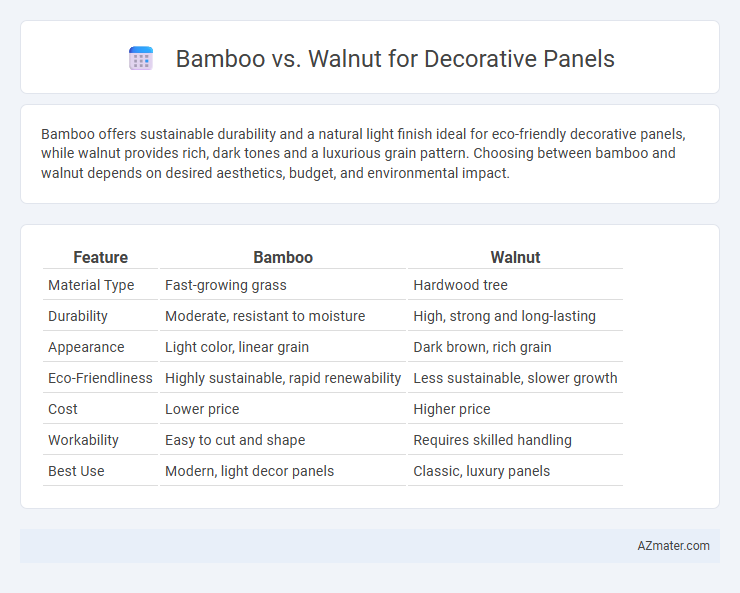Bamboo offers sustainable durability and a natural light finish ideal for eco-friendly decorative panels, while walnut provides rich, dark tones and a luxurious grain pattern. Choosing between bamboo and walnut depends on desired aesthetics, budget, and environmental impact.
Table of Comparison
| Feature | Bamboo | Walnut |
|---|---|---|
| Material Type | Fast-growing grass | Hardwood tree |
| Durability | Moderate, resistant to moisture | High, strong and long-lasting |
| Appearance | Light color, linear grain | Dark brown, rich grain |
| Eco-Friendliness | Highly sustainable, rapid renewability | Less sustainable, slower growth |
| Cost | Lower price | Higher price |
| Workability | Easy to cut and shape | Requires skilled handling |
| Best Use | Modern, light decor panels | Classic, luxury panels |
Introduction to Decorative Panel Materials
Bamboo and walnut stand out as popular materials for decorative panels, each offering unique aesthetic and functional qualities. Bamboo provides eco-friendly durability with a light, natural grain ideal for modern, sustainable designs, while walnut boasts rich, dark hues and intricate patterns suited for classic, elegant interiors. Both materials enhance spaces by combining strength with visual appeal, catering to diverse design preferences and architectural needs.
Overview of Bamboo Panels
Bamboo panels offer a sustainable and eco-friendly alternative to traditional hardwoods like walnut for decorative applications, characterized by their rapid growth and high tensile strength. These panels feature a unique grain pattern with natural variations, providing a modern, minimalist aesthetic often favored in contemporary interior design. Bamboo's resistance to moisture and insects adds durability, making it suitable for both residential and commercial decorative paneling projects.
Overview of Walnut Panels
Walnut panels offer a rich, dark hue with natural grain patterns that elevate the aesthetic of decorative walls and furniture. Known for their durability and stability, walnut panels resist warping and provide a luxurious finish ideal for high-end interior design. Compared to bamboo, walnut presents a more classic and warm appearance, often preferred in traditional and contemporary spaces seeking elegance and timeless appeal.
Aesthetic Differences: Bamboo vs Walnut
Bamboo panels offer a light, airy aesthetic with natural linear grain patterns and a subtle golden hue, ideal for modern and minimalist interiors. Walnut panels exhibit a rich, deep brown color with complex, swirling grain textures that provide a luxurious and timeless appeal. The contrast in color intensity and grain complexity between bamboo and walnut significantly influences the overall ambiance and style of decorative panel installations.
Durability and Strength Comparison
Bamboo offers exceptional tensile strength and flexibility, making it highly durable and resistant to impact for decorative panels, while its rapid growth contributes to sustainability. Walnut, a dense hardwood, provides superior hardness and resistance to wear, ensuring long-lasting aesthetic appeal and structural integrity in decorative applications. When comparing durability, walnut resists dents and scratches better, but bamboo's resilience to moisture and its eco-friendly nature make it a strong contender for durable decorative panels.
Environmental Impact and Sustainability
Bamboo panels offer a significantly lower environmental impact compared to walnut due to their rapid growth rates, typically reaching maturity in 3-5 years, which enables quicker replenishment and reduces deforestation risks. Walnut trees grow much slower, often taking several decades to mature, resulting in a greater strain on forest ecosystems and less sustainable harvesting practices. Utilizing bamboo for decorative panels promotes better carbon sequestration and reduces habitat destruction, aligning with sustainable design principles.
Cost and Availability
Bamboo decorative panels typically offer a more cost-effective solution due to rapid renewability and lower production expenses compared to walnut, which is a premium hardwood with a higher price point driven by limited supply and longer growth cycles. Availability of bamboo is generally more consistent worldwide, benefiting from sustainable farming practices across Asia, whereas walnut panels may face regional scarcity and fluctuating market prices, especially in North America and Europe. Budget-conscious projects often favor bamboo for its affordability and eco-friendly attributes, while walnut is chosen for luxury applications requiring rich grain and durability.
Installation and Maintenance Considerations
Bamboo decorative panels offer lightweight installation with easy cutting and fastening, making them ideal for DIY projects, while walnut panels require professional handling due to their density and hardness. Maintenance for bamboo involves periodic cleaning with mild soap and water to prevent mold or discoloration, whereas walnut panels need regular polishing and conditioning to maintain their rich, dark finish. Both materials benefit from controlled humidity environments to prevent warping and ensure long-term durability.
Best Applications for Bamboo Panels
Bamboo panels excel in decorative applications where sustainability and moisture resistance are priorities, making them ideal for kitchens, bathrooms, and outdoor feature walls. Their natural flexibility and fast growth rate offer an eco-friendly alternative to traditional hardwoods like walnut, which is better suited for high-end furniture and cabinetry due to its rich grain and durability. Bamboo's unique texture and ability to be easily laminated also make it a preferred choice for modern interior accents and commercial spaces aiming for a contemporary, green aesthetic.
Best Applications for Walnut Panels
Walnut panels offer a rich, deep grain pattern and luxurious dark tone that makes them ideal for high-end decorative wall cladding, furniture accents, and feature walls in residential and commercial interiors. Their durability and natural resistance to wear suit applications where both aesthetics and longevity are essential, such as executive offices, upscale restaurants, and luxury retail spaces. Walnut's ability to develop a warm patina over time enhances its appeal in spaces requiring an elegant, timeless look.

Infographic: Bamboo vs Walnut for Decorative Panel
 azmater.com
azmater.com